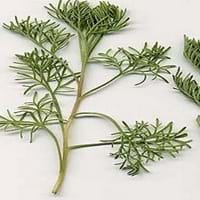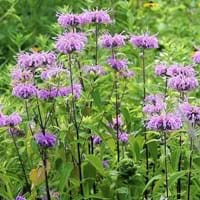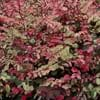Life Span
Perennial
Perennial
Origin
Southern Europe
North America, Northeastern United States, Mid-Atlantic United States, Southeastern United States, North-Central United States, Central United States, South-Central United States, Texas, Canada
Types
not available
Monarda fistulosa brevis, Monarda fistulosa fistulosa, Monarda fistulosa mollis
Number of Varieties
Not Available
Habitat
Temperate Regions
Thickets, Woodland edges
USDA Hardiness Zone
5-8
Not Available
Sunset Zone
2b, 3a, 3b, 4, 5, 6, 7, 8, 9, 10, 11, 12, 13, 14, 15, 16, 17, 18, 19, 20, 21, 22, 23, 24
Not Available
Habit
Upright/Erect
Clump-Forming
Minimum Height
Not Available
Minimum Width
Not Available
Flower Color
Yellow, Gray
Not Available
Flower Color Modifier
Not Available
Bicolor
Fruit Color
Non Fruiting Plant
Not Available
Leaf Color in Spring
Gray Green
Not Available
Leaf Color in Summer
Gray Green
Not Available
Leaf Color in Fall
Gray Green
Not Available
Leaf Color in Winter
Not Available
Light Green
Leaf Shape
Long hair-like leaves
Lance shaped
Plant Season
Spring, Summer, Fall
Spring, Summer
Sunlight
Full Sun
Full Sun, Partial Sun
Growth Rate
Medium
Medium
Type of Soil
Loam
Clay, Loam, Sand
The pH of Soil
Neutral
Acidic, Neutral, Alkaline
Soil Drainage
Well drained
Average
Bloom Time
Late Summer
Not Available
Tolerances
Not Available
Drought, Heat Tolerance, Sun
Where to Plant?
Ground, Pot
Ground
How to Plant?
Cuttings, Seedlings
Seedlings
Plant Maintenance
Medium
Medium
Watering Requirements
Average Water Needs, Keep the Soil well drained
Medium
In Summer
Lots of watering
Lots of watering
In Spring
Moderate
Moderate
In Winter
Average Water
Average Water
Soil pH
Neutral
Acidic, Neutral, Alkaline
Soil Type
Loam
Clay, Loam, Sand
Soil Drainage Capacity
Well drained
Average
Sun Exposure
Full Sun
Full Sun, Partial Sun
Pruning
Cut back old stems to the ground, Remove damaged leaves, Remove dead branches, Remove dead leaves
Cut or pinch the stems, Remove damaged leaves, Remove dead branches, Remove dead flowers, Remove dead leaves, Remove deadheads
Fertilizers
All-Purpose Liquid Fertilizer, Complete balanced fertilizer
All-Purpose Liquid Fertilizer
Pests and Diseases
Free of serious pests and diseases
Powdery mildew, Rust
Plant Tolerance
Drought
Drought, Heat Tolerance, Sun
Flowers
Insignificant
Yes
Flower Petal Number
Not Available
Not Available
Fragrant Bark/Stem
No
Yes
Foliage Texture
Medium
Not Available
Foliage Sheen
Matte
Not Available
Attracts
Not Available
Bees, Hummingbirds
Allergy
Skin irritation
Not Available
Aesthetic Uses
Farmland, small hedge, Wild gardens
Beautification, Cottage Garden, Showy Purposes
Beauty Benefits
Not Available
Skin inflammation, Skin Problems
Environmental Uses
Air purification
Air purification
Medicinal Uses
Antiseptic, Digestive, Liver problems, Skin Disorders, Tonic
Antiseptic, Carminative, Diaphoretic, Diuretic, Gastrointestinal disorders
Part of Plant Used
Branch, Fibres, Flower Stalk, Gum, Leaves, Twigs
Flowers, Leaves, Stem
Other Uses
Oil is used in mosquito repellents, Used for fragrance, Used to make hair tonic
Added to salads, Used as a flavouring in food, Used as a potherb, Used as Ornamental plant
Used As Indoor Plant
No
No
Used As Outdoor Plant
Yes
Yes
Garden Design
Herb, Vegetable, Mixed Border, Rock Garden, Wall
Cutflower, Edible, Mixed Border, Wildflower
Botanical Name
ARTEMISIA abrotanum
MONARDA fistulosa
Common Name
lad's love , southern wormwood , old man , boy's love , appleringie , sitherwood
Wild Bergamot, bee balm
In Hindi
southernwood
Wild Bergamot
In German
Eberraute
Wilde Bergamotte
In French
aurone ou citronnelle
bergamote sauvage
In Spanish
Artemisia abrotanum
bergamota silvestre
In Greek
Artemisia abrotanum
άγρια Περγαμόντο
In Portuguese
Abrótano
Bergamota selvagem
In Polish
Bylica boże drzewko
Dziki Bergamot
In Latin
Southernwood
Wild Bergamot
Phylum
Magnoliophyta
Magnoliophyta
Class
Magnoliopsida
Magnoliopsida
Family
Asteraceae
Lamiaceae
Clade
Angiosperms, Asterids, Eudicots
Angiosperms, Asterids, Eudicots
Tribe
Anthemideae
Mentheae
Subfamily
Asteroideae
Nepetoideae
Number of Species
Not Available
Season and Care of Southernwood and Wild Bergamot
Season and care of Southernwood and Wild Bergamot is important to know. While considering everything about Southernwood and Wild Bergamot Care, growing season is an essential factor. Southernwood season is Spring, Summer and Fall and Wild Bergamot season is Spring, Summer and Fall. The type of soil for Southernwood is Loam and for Wild Bergamot is Clay, Loam, Sand while the PH of soil for Southernwood is Neutral and for Wild Bergamot is Acidic, Neutral, Alkaline.
Southernwood and Wild Bergamot Physical Information
Southernwood and Wild Bergamot physical information is very important for comparison. Southernwood height is Not Available and width Not Available whereas Wild Bergamot height is 90.00 cm and width 45.70 cm. The color specification of Southernwood and Wild Bergamot are as follows:
Southernwood flower color: Yellow and Gray
Southernwood leaf color: Gray Green
Wild Bergamot flower color: Not Available
- Wild Bergamot leaf color: Not Available
Care of Southernwood and Wild Bergamot
Care of Southernwood and Wild Bergamot include pruning, fertilizers, watering etc. Southernwood pruning is done Cut back old stems to the ground, Remove damaged leaves, Remove dead branches and Remove dead leaves and Wild Bergamot pruning is done Cut or pinch the stems, Remove damaged leaves, Remove dead branches, Remove dead flowers, Remove dead leaves and Remove deadheads. In summer Southernwood needs Lots of watering and in winter, it needs Average Water. Whereas, in summer Wild Bergamot needs Lots of watering and in winter, it needs Average Water.





